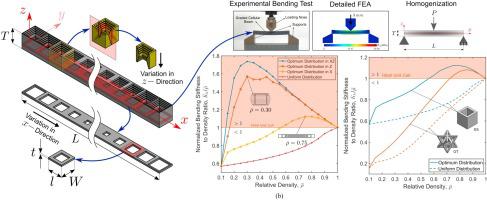Additive Manufacturing ( IF 10.3 ) Pub Date : 2020-05-23 , DOI: 10.1016/j.addma.2020.101327 A. Seyedkanani , H. Niknam , A.H. Akbarzadeh

|
Periodic cellular materials can substantially improve the stiffness-to-weight ratio of structures. This improvement depends on the geometry of periodic cells. This article presents the idea of enhancing the bending stiffness of an architected cellular beam by an optimum distribution of relative density through its length and/or across its thickness. We employ a hybrid-homogenized model to expedite the computational evaluation of the bending performance of the graded cellular beams. Detailed finite element analysis (FEA) and experimental bending tests on specimens 3D printed by stereolithography validate the hybrid-homogenized modeling approach. The hybrid-homogenized model facilitates transforming the general optimization problem into a shape optimization process with the relative density of unit cells as design variables. The teaching-learning-based optimization (TLBO) algorithm is used to obtain the optimum relative density distribution, which maximizes the bending stiffness. The optimization results show a substantial increase in bending stiffness; as high as 43%, 155%, and 182% for a cellular beam graded through the length, across the thickness, and in both directions, respectively. It is found that varying the relative density of cells across the beam thickness is more effective than variation through the length. Detailed FEA and experimental bending tests corroborate the optimization findings and confirm the practicality of such graded designs for developing advanced lightweight structures. Investigating the effect of cell architecture also reveals that optimally graded cellular beams have a potential to outperform uniform cellular beams made out of ideal unit cells (Voigt bound for elastic properties) by reaching bending stiffness-to-density ratios greater than one. The relatively simple graded cellular designs are beneficial in applications where high bending stiffness and low density are essential. Recent advances in additive manufacturing promise extending the presented grading strategy for polymeric, composite, and metallic 3D printed cellular materials to fabricate high performance lightweight structural elements at a relatively low cost.
中文翻译:

最佳渐变3D打印蜂窝梁的弯曲行为
周期性的蜂窝材料可以大大提高结构的刚度重量比。这种改进取决于周期电池的几何形状。本文提出了通过在其长度和/或整个厚度上相对密度的最佳分布来增强结构化蜂窝梁的弯曲刚度的想法。我们采用混合均质模型来加速渐变蜂窝梁弯曲性能的计算评估。详细的有限元分析(FEA)和通过立体光刻技术对3D样本进行的实验弯曲测试验证了混合均质化建模方法的有效性。混合均匀化模型有助于将一般优化问题转换为形状优化过程,并以晶胞的相对密度作为设计变量。基于教学学习的优化(TLBO)算法用于获得最佳相对密度分布,从而使弯曲刚度最大化。优化结果表明,弯曲刚度大大提高。在整个长度,整个厚度和两个方向上渐变的蜂窝光束分别高达43%,155%和182%。发现在整个光束厚度上改变单元的相对密度比改变整个长度更有效。详细的有限元分析和实验弯曲测试证实了优化结果,并证实了这种分级设计对于开发高级轻型结构的实用性。研究单元结构的效果还表明,通过达到大于1的弯曲刚度/密度比,最佳分级的单元梁具有优于由理想单位单元(Voigt绑定为弹性性质)制成的均匀单元梁的潜力。相对简单的渐变蜂窝设计在需要高弯曲刚度和低密度的应用中非常有用。增材制造的最新进展有望扩展目前针对聚合物,复合材料和金属3D打印蜂窝材料的分级策略,从而以相对较低的成本制造高性能的轻型结构元件。相对简单的渐变蜂窝设计在需要高弯曲刚度和低密度的应用中非常有用。增材制造的最新进展有望扩展目前针对聚合物,复合材料和金属3D打印蜂窝材料的分级策略,从而以相对较低的成本制造高性能的轻型结构元件。相对简单的渐变蜂窝设计在需要高弯曲刚度和低密度的应用中非常有用。增材制造的最新进展有望扩展目前针对聚合物,复合材料和金属3D打印蜂窝材料的分级策略,从而以相对较低的成本制造高性能的轻型结构元件。











































 京公网安备 11010802027423号
京公网安备 11010802027423号